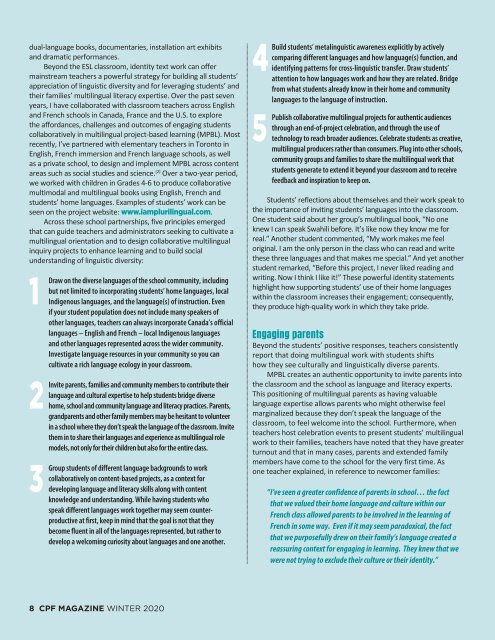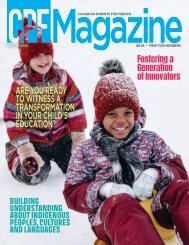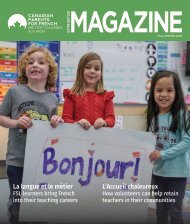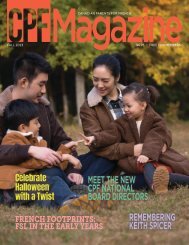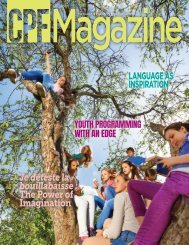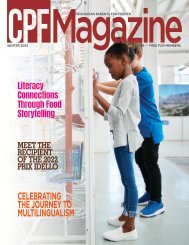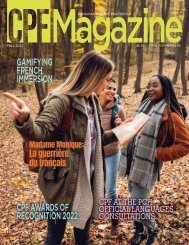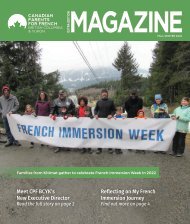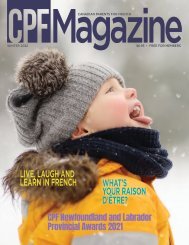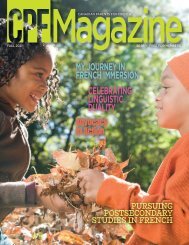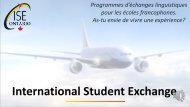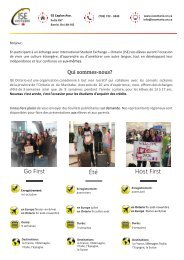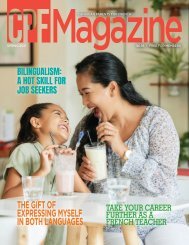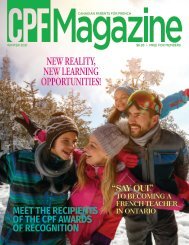CPF Magazine Winter 2020 Issue
A national network of volunteers, parents and stakeholders who value French as an integral part of Canada. CPF Magazine is dedicated to the promotion and creation of French-second-language learning opportunities for young Canadians.
A national network of volunteers, parents and stakeholders who value French as an integral part of Canada. CPF Magazine is dedicated to the promotion and creation of French-second-language learning opportunities for young Canadians.
You also want an ePaper? Increase the reach of your titles
YUMPU automatically turns print PDFs into web optimized ePapers that Google loves.
dual-language books, documentaries, installation art exhibits<br />
and dramatic performances.<br />
Beyond the ESL classroom, identity text work can offer<br />
mainstream teachers a powerful strategy for building all students’<br />
appreciation of linguistic diversity and for leveraging students’ and<br />
their families’ multilingual literacy expertise. Over the past seven<br />
years, I have collaborated with classroom teachers across English<br />
and French schools in Canada, France and the U.S. to explore<br />
the affordances, challenges and outcomes of engaging students<br />
collaboratively in multilingual project-based learning (MPBL). Most<br />
recently, I’ve partnered with elementary teachers in Toronto in<br />
English, French immersion and French language schools, as well<br />
as a private school, to design and implement MPBL across content<br />
areas such as social studies and science. [2] Over a two-year period,<br />
we worked with children in Grades 4-6 to produce collaborative<br />
multimodal and multilingual books using English, French and<br />
students’ home languages. Examples of students’ work can be<br />
seen on the project website: www.iamplurilingual.com.<br />
Across these school partnerships, five principles emerged<br />
that can guide teachers and administrators seeking to cultivate a<br />
multilingual orientation and to design collaborative multilingual<br />
inquiry projects to enhance learning and to build social<br />
understanding of linguistic diversity:<br />
1<br />
Draw<br />
2<br />
Invite<br />
3<br />
Group<br />
on the diverse languages of the school community, including<br />
but not limited to incorporating students’ home languages, local<br />
Indigenous languages, and the language(s) of instruction. Even<br />
if your student population does not include many speakers of<br />
other languages, teachers can always incorporate Canada’s official<br />
languages – English and French – local Indigenous languages<br />
and other languages represented across the wider community.<br />
Investigate language resources in your community so you can<br />
cultivate a rich language ecology in your classroom.<br />
parents, families and community members to contribute their<br />
language and cultural expertise to help students bridge diverse<br />
home, school and community language and literacy practices. Parents,<br />
grandparents and other family members may be hesitant to volunteer<br />
in a school where they don’t speak the language of the classroom. Invite<br />
them in to share their languages and experience as multilingual role<br />
models, not only for their children but also for the entire class.<br />
students of different language backgrounds to work<br />
collaboratively on content-based projects, as a context for<br />
developing language and literacy skills along with content<br />
knowledge and understanding. While having students who<br />
speak different languages work together may seem counterproductive<br />
at first, keep in mind that the goal is not that they<br />
become fluent in all of the languages represented, but rather to<br />
develop a welcoming curiosity about languages and one another.<br />
4<br />
Build<br />
5<br />
Publish<br />
students’ metalinguistic awareness explicitly by actively<br />
comparing different languages and how language(s) function, and<br />
identifying patterns for cross-linguistic transfer. Draw students’<br />
attention to how languages work and how they are related. Bridge<br />
from what students already know in their home and community<br />
languages to the language of instruction.<br />
collaborative multilingual projects for authentic audiences<br />
through an end-of-project celebration, and through the use of<br />
technology to reach broader audiences. Celebrate students as creative,<br />
multilingual producers rather than consumers. Plug into other schools,<br />
community groups and families to share the multilingual work that<br />
students generate to extend it beyond your classroom and to receive<br />
feedback and inspiration to keep on.<br />
Students’ reflections about themselves and their work speak to<br />
the importance of inviting students’ languages into the classroom.<br />
One student said about her group’s multilingual book, “No one<br />
knew I can speak Swahili before. It’s like now they know me for<br />
real.” Another student commented, “My work makes me feel<br />
original. I am the only person in the class who can read and write<br />
these three languages and that makes me special.” And yet another<br />
student remarked, “Before this project, I never liked reading and<br />
writing. Now I think I like it!” These powerful identity statements<br />
highlight how supporting students’ use of their home languages<br />
within the classroom increases their engagement; consequently,<br />
they produce high-quality work in which they take pride.<br />
Engaging parents<br />
Beyond the students’ positive responses, teachers consistently<br />
report that doing multilingual work with students shifts<br />
how they see culturally and linguistically diverse parents.<br />
MPBL creates an authentic opportunity to invite parents into<br />
the classroom and the school as language and literacy experts.<br />
This positioning of multilingual parents as having valuable<br />
language expertise allows parents who might otherwise feel<br />
marginalized because they don’t speak the language of the<br />
classroom, to feel welcome into the school. Furthermore, when<br />
teachers host celebration events to present students’ multilingual<br />
work to their families, teachers have noted that they have greater<br />
turnout and that in many cases, parents and extended family<br />
members have come to the school for the very first time. As<br />
one teacher explained, in reference to newcomer families:<br />
“ I’ve seen a greater confidence of parents in school… the fact<br />
that we valued their home language and culture within our<br />
French class allowed parents to be involved in the learning of<br />
French in some way. Even if it may seem paradoxical, the fact<br />
that we purposefully drew on their family’s language created a<br />
reassuring context for engaging in learning. They knew that we<br />
were not trying to exclude their culture or their identity.”<br />
8 <strong>CPF</strong> MAGAZINE WINTER <strong>2020</strong>


